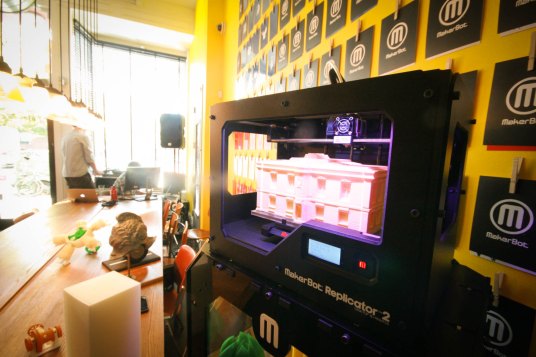
MakerBot continues its ascent
But as big as that move was, MakerBot’s September was even bigger. Not only did CEO Bre Pettis land on the cover of Wired magazine, but MakerBot also announced the Replicator 2 and Replicator X, its newest 3D printers. To top it off, MakerBot also launched its very own storefront in Manhattan, where customers can see for themselves just how far 3D printing has come this year.
Shapeways shapes 3D printing’s future
AI Weekly
The must-read newsletter for AI and Big Data industry written by Khari Johnson, Kyle Wiggers, and Seth Colaner.
Included with VentureBeat Insider and VentureBeat VIP memberships.
It’s a brilliant business model, and it’s worked out pretty well for Shapeways this year. In June, it raised $6.2 million, funding that became vital when Shapeways opened up its new Queens, New York printing factory in October. Equipped with 50 industrial printers, the factory can generate millions of products a year. The move, like MakerBot’s expansion, is proof that the 3D printing industry is growing — and quickly.
Bringing 3D printing to the bedroom
One startup, New York Toy Collective, takes that capability a step further: Using 3D photography, the team is even able to make anatomically correct replicas of its customers’ genitals. The future is here and it’s … well, sexy.
3D printed guns reveal the technology’s dark side
While limited in its scope, the project shows that 3D printers won’t just disrupt manufacturing, but law enforcement and gun control as well. How can you prevent people from buying things — in this case, guns — that they can create in their own homes?
Fortunately for civil society, consumer-grade 3D printers are still unable to print in sturdier materials like metal, which thankfully prevents them from printing entire weapons — at least for now.
[aditude-amp id="medium1" targeting='{"env":"staging","page_type":"article","post_id":589903,"post_type":"story","post_chan":"none","tags":null,"ai":false,"category":"none","all_categories":"business,","session":"D"}']
3D printing helps pirates discover a new target
Online piracy has created a lot of headaches for media and software companies, and the Pirate Bay plans to bring the pain to makers of physical objects as well. The torrent site’s new “Physibles” category enables people to upload 3D designs, which anyone with a 3D printer can print out in their own homes. While the move might seem pretty insidious, The Pirate Bay points to more noble motives: “The benefit to society is huge. No more shipping huge amount of products around the world. No more shipping the broken products back. No more child labor,” the site wrote announcing the addition.
3D printing warms our hearts
“[Additive printing] is one of those industries that matches perfectly with 3D printing, because we need custom everything,” research designer Whitney Sample says the video. 3D printing severely cuts down on both the wait time and costs of medial prosthetics. Rather than take patents’ measurements, send them to a company, and wait for the prosthetics to arrive, hospitals can just print them themselves. It sounds fanciful, but as the video above shows, it’s already being done.
[aditude-amp id="medium2" targeting='{"env":"staging","page_type":"article","post_id":589903,"post_type":"story","post_chan":"none","tags":null,"ai":false,"category":"none","all_categories":"business,","session":"D"}']
Staples helps create a spooky future
VentureBeat's mission is to be a digital town square for technical decision-makers to gain knowledge about transformative enterprise technology and transact. Learn More
